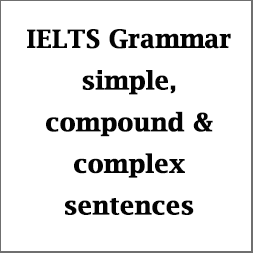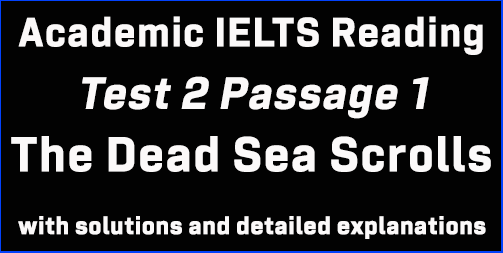IELTS Grammar: identifying simple, compound & complex sentences; with techniques, explanations & examples
Many IELTS candidates have requested me to give a post on ‘how to understand or recognize simple, compound and complex sentences’ in a very easy way. It is necessary for IELTS candidates not only to understand simple, compound and complex sentences but also know how to write them correctly. In IELTS Reading, they are used quite often; they are also important to get a higher band in IELTS Writing and Speaking. This post focuses on the understanding and uses of simple, compound and complex sentences.

To understand the differences among simple, compound, and complex sentences, we need to have a clear idea about ‘clause’.
Let’s take a look at the following sentences:
I know that he is honest.
He knows when I will reach.
There is a rumor that he is ill.
If you look closely at the sentences, you will find two Finite Verbs and two Subjects in each sentence.
What is a finite verb?
A finite verb is a form of a verb that has a subject (expressed or implied) and can function as the root of an independent clause; an independent clause can, in turn, stand alone as a complete sentence. (source: Wikipedia)
In short, a finite verb completes a sentence.
Each finite verb, along with its subject, is working as one part of speech. Such a part of a sentence is known as a clause.
So, in those three sentences above, I know, he is honest, He knows, I will reach, There is a rumor and he is ill, all are clauses.
A technique to remember the difference between a finite and a non-finite verb:
A finite verb always follows any of the twelve tense rules.
A non-finite verb doesn’t follow any rules of the twelve tenses.
For example:
- I saw him going.
Here, saw is a finite verb; going is a non-finite verb.
- She has come to see me.
Here, has come is a finite verb; to see is a non-finite verb.
- Having done the work, I took some rest.
Here, took is a finite verb; having done is a non-finite verb.
So, have you understood what a clause is?
Now, here are some facts to remember about the clauses.
- A clause can be a complete sentence or a part of a bigger sentence.
- A sentence has at least one clause.
- If there are three clauses in a sentence, it means there are three subjects and three finite verbs.
Look at the following sentences:
I asked the girl who she was and what she wanted. (three finite verbs = three clauses)
Education means what remains after one has forgot what he/she learnt in school/ college/ university. (four finite verbs = four clauses)
Classification of clauses:
Look at the following diagram:

Simple sentence:
If the sentence contains only one clause, then this clause is known as the main/principal/independent clause.
A simple sentence contains only one clause.
Look at the example:
I know his living place.
In this sentence, there is only one finite verb (know) and only one subject (I). ‘Living’ is a non-finite verb here. So, here ‘I know’ is the independent/main/principal clause and this sentence is a simple sentence.
So simple, isn’t it?
Now here are some practice sentences for you. Don’t let the verbs fool you, ok?
I love my cat.
I like the concept of living in a dream.
She is a genius in solving analytical problems.
The little boys and girls go to school together by their school bus rather than walking.
I’ll walk instead of running.
We worked as per our employer’s order.
All these sentences are simple sentences.
Compound sentence:
A sentence containing a main/independent/principal clause and a co-ordinate clause is known as a compound sentence.
A co-ordinate clause is a sentence that starts with a co-ordinate conjunction. There are some co-ordinate conjunctions so we need a mnemonic to remember them. It is “FANBOYES”.
FANBOYES means the followings:
*F = for
*A = and
*N = not only… but also / Neither….nor
*B = but / both….and
*O = or / otherwise
*Y = yet
*E = Either….or
*S = so / therefore
So, if any clause starts with any of the given conjunctions, it will be a co-ordinate clause and the sentence will be a compound sentence.
Here are some examples:
He is poor but he is honest. / He is poor but honest.
He was punished for he was dishonest.
I was angry and I called the police.
He has many shortcomings yet I like his attitude.
Do or die.
She likes to play but her mother doesn’t.
Do the work otherwise I shall be angry.
Either my brother or his friend did this.
Not only my teachers but also my parents were surprised.
All these sentences have a co-ordinate clause. So, they are all compound sentences.
Complex sentence:
A complex sentence is formed with a main/principal/independent clause and a subordinate clause.
A subordinate clause starts with a subordinate conjunction.
Mnemonic: A subordinate clause doesn’t start with any of “FANBOYES”. Rather it starts with other conjunctions like the followings:
All wh-words: what, when, where, who, whose, whom, why, which, how,
and conjunctions like
that, in that, in order that, provided that, so that, so……that, so, so…..as, as…..as, as, as if, though, although, while, because, since, lest, whether…… not, etc.
Here are some examples:
Money flows where money is.
The person who is tired of love is tired of life.
A dolphin differs from a porpoise in that it has a longer nose.
Though I want the money, I’m not going to steal it.
Where there is a will, there is a way.
They came to see me when it was late.
I came here so that you could understand me.
She was so shy that she did not speak at all.
All these sentences have a subordinate clause and so they are complex sentences.
I hope you have understood the differences so far.
Now, subordinate clauses are of three types: Noun clause, Adjective clause & adverb clause. Let’s have a look at them.
Noun clause:
Identifying a noun clause is easy. You need to check whether the clause can be replaced by the word ‘it’. If the clause can be replaced, it is a noun clause.
Look at the following example:
What the minister said was interesting.
Now, if we replace the clause “What the minister said” with “it”, the sentence becomes:
It was interesting.
Here are some more examples:
Tell me how I can help you. Or, Tell me it.
I am happy with what I have. Or, I am happy with it.
Adjective clause:
An adjective clause has an antecedent before it.
To understand adjective clause, we need to understand the term ‘antecedent’.
An antecedent in a complex sentence is the word (or words) that a relative pronoun (wh-words, that) refers to.
Look at the example:
I know the man who helped me.
Here, the word ‘who’ is a relative pronoun and it refers to the previous word ‘the man’. So, ‘the man’ is an antecedent for ‘who’.
They know the place where Mustafa lives.
‘the place’ = antecedent for ‘where’.
The police caught the burglar who attacked the little boy too.
‘the burglar’ = antecedent for ‘who’.
We saw the wave which came with a gigantic force.
‘the wave’ = antecedent for ‘which’.
So, all these subordinate clauses are adjective clauses.
Here are some more examples:
The man who lives across the street is my uncle.
The notebook that is on the table belongs to Celia.
Did you go to the same university that my cousin Jim went to?
I can see the bird that is on the fence.
I like to order burgers, which is also my brother’s favorite.
Adverb clause:
An adverb clause cannot be replaced by the word ‘it’ and does not contain any antecedent.
Examples:
I shall go where she lives.
She will do the job when you want.
Roben walked as if he were very sick.
Because she got a scholarship, she had no monetary problem.
When the storm comes, we better be ready.
If you tell me, I shall help you.
I hope this post has helped you understand and identify simple, compound and complex sentences. Remember to practice them by writing some sentences.
Click here for IELTS vocabulary: 52 most common & important words; with meanings & example sentences
Click here for IELTS vocabulary practice: list of words to use instead of ‘very’




best explanation in short time to go through grammar.Thank u ..for it.